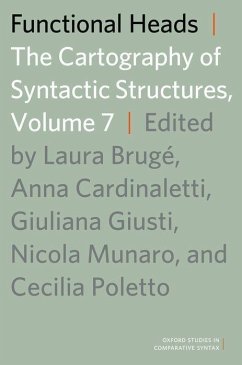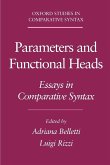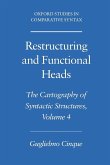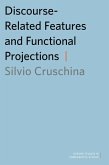Functional Heads
The Cartography of Syntactic Structures, Volume 7
Herausgeber: Brug, Laura; Giusti, Giuliana; Cardinaletti, Anna
Functional Heads
The Cartography of Syntactic Structures, Volume 7
Herausgeber: Brug, Laura; Giusti, Giuliana; Cardinaletti, Anna
- Broschiertes Buch
- Merkliste
- Auf die Merkliste
- Bewerten Bewerten
- Teilen
- Produkt teilen
- Produkterinnerung
- Produkterinnerung
The cartographic project considers evidence for a functional head in one language as evidence for it in universal grammar. In this volume, some of the most influential linguists who have participated in this long-lasting debate offer their recent work in short, self contained case studies.
Andere Kunden interessierten sich auch für
![Parameters and Functional Heads Parameters and Functional Heads]() Rizzi BellettiParameters and Functional Heads78,99 €
Rizzi BellettiParameters and Functional Heads78,99 €![Restructuring and Functional Heads Restructuring and Functional Heads]() Guglielmo CinqueRestructuring and Functional Heads77,99 €
Guglielmo CinqueRestructuring and Functional Heads77,99 €![Adverbs and Functional Heads Adverbs and Functional Heads]() Guglielmo CinqueAdverbs and Functional Heads163,99 €
Guglielmo CinqueAdverbs and Functional Heads163,99 €![The Higher Functional Field The Higher Functional Field]() Cecilia PolettoThe Higher Functional Field104,99 €
Cecilia PolettoThe Higher Functional Field104,99 €![Discourse-Related Features and Functional Projections Discourse-Related Features and Functional Projections]() Silvio CruschinaDiscourse-Related Features and Functional Projections60,99 €
Silvio CruschinaDiscourse-Related Features and Functional Projections60,99 €![Functional Structure from Top to Toe Functional Structure from Top to Toe]() Peter SvenoniusFunctional Structure from Top to Toe69,99 €
Peter SvenoniusFunctional Structure from Top to Toe69,99 €![Critical Discourse and Corpus Approaches to Systemic Functional Grammar Critical Discourse and Corpus Approaches to Systemic Functional Grammar]() Critical Discourse and Corpus Approaches to Systemic Functional Grammar83,88 €
Critical Discourse and Corpus Approaches to Systemic Functional Grammar83,88 €-
-
-
The cartographic project considers evidence for a functional head in one language as evidence for it in universal grammar. In this volume, some of the most influential linguists who have participated in this long-lasting debate offer their recent work in short, self contained case studies.
Hinweis: Dieser Artikel kann nur an eine deutsche Lieferadresse ausgeliefert werden.
Hinweis: Dieser Artikel kann nur an eine deutsche Lieferadresse ausgeliefert werden.
Produktdetails
- Produktdetails
- Verlag: Oxford University Press
- Seitenzahl: 432
- Erscheinungstermin: 1. Juni 2012
- Englisch
- Abmessung: 234mm x 156mm x 23mm
- Gewicht: 652g
- ISBN-13: 9780199746729
- ISBN-10: 0199746729
- Artikelnr.: 35054070
- Herstellerkennzeichnung
- Libri GmbH
- Europaallee 1
- 36244 Bad Hersfeld
- gpsr@libri.de
- Verlag: Oxford University Press
- Seitenzahl: 432
- Erscheinungstermin: 1. Juni 2012
- Englisch
- Abmessung: 234mm x 156mm x 23mm
- Gewicht: 652g
- ISBN-13: 9780199746729
- ISBN-10: 0199746729
- Artikelnr.: 35054070
- Herstellerkennzeichnung
- Libri GmbH
- Europaallee 1
- 36244 Bad Hersfeld
- gpsr@libri.de
Laura Brugé is a Researcher at the University of Venice. Anna Cardinaletti is Professor of Linguistics at the University of Venice. Giuliana Giusti is Associate Professor of Linguistics at the University of Venice. Nicola Munaro is a Researcher at the University of Venice. Cecilia Poletto is Associate Professor of Linguistics at the University of Frankfurt.
* Introduction, The editors
* Section 1: On the cartography of functional structure
* From modal particle to interrogative marker: A study of German denn,
Josef Bayer
* Lexical complementizers and headless relatives, Paola Benincà
* The theory of syntax and the representation of indexicality,
Alessandra Giorgi
* Wh-Movement as topic movement, Günther Grewendorf
* 'Je est un autre.' Subject positions, point of view and the neuter
pronoun tet in West Flemish, Jacqueline Guéron and Liliane Haegeman
* Number within the DP: A view from Oceanic, Elisabeth Pearce
* Mirative and focusing uses of the Catalan particle pla, Gemma Rigau
* On the nature of the V2 system in Medieval Romance, Giampaolo Salvi
* A note on the Spanish Left Periphery, María Luisa Zubizarreta
* Section 2: On movements and constraints
* Moving verbal chunks in the low functional field, Adriana Belletti
and Luigi Rizzi
* Articles as partitives, Ignacio Bosque and M. Carme Picallo
* Toward an analysis of French Hyper-Complex Inversion, Richard S.
Kayne and Jean-Yves Pollock
* Samoan ergativity as double passives, Hilda Koopman
* Rivisiting "Suspended Affixation" and other coordinate mysteries,
Jaklin Kornfilt
* Backward Binding and the C-T phase: A case of Syntactic Haplology,
Christer Platzack
* On the feature composition of participial light verbs in French,
Andrew Radford and Michèle Vincent
* A note on dative incompatibility suppression, Henk van Riemsdijk
* Hallmarks on Portuguese syntax, Alain Rouveret
* Notes on wh in situ in French, Ur Shlonsky
* Re re again. What French re shows about VP structures, have and be
raising, and the syntax/phonology interface, Dominique Sportiche
* The structural object position of verbs and nouns, Knut Tarald
Taraldsen
* Section 3: On the nature of functional heads
* On the double definiteness, aspect, and word order in Old and Modern
Scandinavian, Werner Abraham
* The order of verbal affixes and functional structure in Imbabura
Quichua, Peter Cole and Gabriella Hermon
* Number as a Feature, Carmen Dobrovie-Sorin
* Which is the extended projection above N?, Joseph Emonds
* On the lexical-functional divide: The case of negation, M. Rita
Manzini and Leonardo M. Savoia
* Diachrony and cartography: Paths of grammaticalisation and the
clausal hierarchy, Ian Roberts
* Silent Heads, Halldór Ármann Sigurðsson and Joan Maling
* Postnominal adjectives in Greek indefinite noun phrases, Melita
Stavrou
* Afterword, Giulio Lepschy and Lorenzo Renzi
* Section 1: On the cartography of functional structure
* From modal particle to interrogative marker: A study of German denn,
Josef Bayer
* Lexical complementizers and headless relatives, Paola Benincà
* The theory of syntax and the representation of indexicality,
Alessandra Giorgi
* Wh-Movement as topic movement, Günther Grewendorf
* 'Je est un autre.' Subject positions, point of view and the neuter
pronoun tet in West Flemish, Jacqueline Guéron and Liliane Haegeman
* Number within the DP: A view from Oceanic, Elisabeth Pearce
* Mirative and focusing uses of the Catalan particle pla, Gemma Rigau
* On the nature of the V2 system in Medieval Romance, Giampaolo Salvi
* A note on the Spanish Left Periphery, María Luisa Zubizarreta
* Section 2: On movements and constraints
* Moving verbal chunks in the low functional field, Adriana Belletti
and Luigi Rizzi
* Articles as partitives, Ignacio Bosque and M. Carme Picallo
* Toward an analysis of French Hyper-Complex Inversion, Richard S.
Kayne and Jean-Yves Pollock
* Samoan ergativity as double passives, Hilda Koopman
* Rivisiting "Suspended Affixation" and other coordinate mysteries,
Jaklin Kornfilt
* Backward Binding and the C-T phase: A case of Syntactic Haplology,
Christer Platzack
* On the feature composition of participial light verbs in French,
Andrew Radford and Michèle Vincent
* A note on dative incompatibility suppression, Henk van Riemsdijk
* Hallmarks on Portuguese syntax, Alain Rouveret
* Notes on wh in situ in French, Ur Shlonsky
* Re re again. What French re shows about VP structures, have and be
raising, and the syntax/phonology interface, Dominique Sportiche
* The structural object position of verbs and nouns, Knut Tarald
Taraldsen
* Section 3: On the nature of functional heads
* On the double definiteness, aspect, and word order in Old and Modern
Scandinavian, Werner Abraham
* The order of verbal affixes and functional structure in Imbabura
Quichua, Peter Cole and Gabriella Hermon
* Number as a Feature, Carmen Dobrovie-Sorin
* Which is the extended projection above N?, Joseph Emonds
* On the lexical-functional divide: The case of negation, M. Rita
Manzini and Leonardo M. Savoia
* Diachrony and cartography: Paths of grammaticalisation and the
clausal hierarchy, Ian Roberts
* Silent Heads, Halldór Ármann Sigurðsson and Joan Maling
* Postnominal adjectives in Greek indefinite noun phrases, Melita
Stavrou
* Afterword, Giulio Lepschy and Lorenzo Renzi
* Introduction, The editors
* Section 1: On the cartography of functional structure
* From modal particle to interrogative marker: A study of German denn,
Josef Bayer
* Lexical complementizers and headless relatives, Paola Benincà
* The theory of syntax and the representation of indexicality,
Alessandra Giorgi
* Wh-Movement as topic movement, Günther Grewendorf
* 'Je est un autre.' Subject positions, point of view and the neuter
pronoun tet in West Flemish, Jacqueline Guéron and Liliane Haegeman
* Number within the DP: A view from Oceanic, Elisabeth Pearce
* Mirative and focusing uses of the Catalan particle pla, Gemma Rigau
* On the nature of the V2 system in Medieval Romance, Giampaolo Salvi
* A note on the Spanish Left Periphery, María Luisa Zubizarreta
* Section 2: On movements and constraints
* Moving verbal chunks in the low functional field, Adriana Belletti
and Luigi Rizzi
* Articles as partitives, Ignacio Bosque and M. Carme Picallo
* Toward an analysis of French Hyper-Complex Inversion, Richard S.
Kayne and Jean-Yves Pollock
* Samoan ergativity as double passives, Hilda Koopman
* Rivisiting "Suspended Affixation" and other coordinate mysteries,
Jaklin Kornfilt
* Backward Binding and the C-T phase: A case of Syntactic Haplology,
Christer Platzack
* On the feature composition of participial light verbs in French,
Andrew Radford and Michèle Vincent
* A note on dative incompatibility suppression, Henk van Riemsdijk
* Hallmarks on Portuguese syntax, Alain Rouveret
* Notes on wh in situ in French, Ur Shlonsky
* Re re again. What French re shows about VP structures, have and be
raising, and the syntax/phonology interface, Dominique Sportiche
* The structural object position of verbs and nouns, Knut Tarald
Taraldsen
* Section 3: On the nature of functional heads
* On the double definiteness, aspect, and word order in Old and Modern
Scandinavian, Werner Abraham
* The order of verbal affixes and functional structure in Imbabura
Quichua, Peter Cole and Gabriella Hermon
* Number as a Feature, Carmen Dobrovie-Sorin
* Which is the extended projection above N?, Joseph Emonds
* On the lexical-functional divide: The case of negation, M. Rita
Manzini and Leonardo M. Savoia
* Diachrony and cartography: Paths of grammaticalisation and the
clausal hierarchy, Ian Roberts
* Silent Heads, Halldór Ármann Sigurðsson and Joan Maling
* Postnominal adjectives in Greek indefinite noun phrases, Melita
Stavrou
* Afterword, Giulio Lepschy and Lorenzo Renzi
* Section 1: On the cartography of functional structure
* From modal particle to interrogative marker: A study of German denn,
Josef Bayer
* Lexical complementizers and headless relatives, Paola Benincà
* The theory of syntax and the representation of indexicality,
Alessandra Giorgi
* Wh-Movement as topic movement, Günther Grewendorf
* 'Je est un autre.' Subject positions, point of view and the neuter
pronoun tet in West Flemish, Jacqueline Guéron and Liliane Haegeman
* Number within the DP: A view from Oceanic, Elisabeth Pearce
* Mirative and focusing uses of the Catalan particle pla, Gemma Rigau
* On the nature of the V2 system in Medieval Romance, Giampaolo Salvi
* A note on the Spanish Left Periphery, María Luisa Zubizarreta
* Section 2: On movements and constraints
* Moving verbal chunks in the low functional field, Adriana Belletti
and Luigi Rizzi
* Articles as partitives, Ignacio Bosque and M. Carme Picallo
* Toward an analysis of French Hyper-Complex Inversion, Richard S.
Kayne and Jean-Yves Pollock
* Samoan ergativity as double passives, Hilda Koopman
* Rivisiting "Suspended Affixation" and other coordinate mysteries,
Jaklin Kornfilt
* Backward Binding and the C-T phase: A case of Syntactic Haplology,
Christer Platzack
* On the feature composition of participial light verbs in French,
Andrew Radford and Michèle Vincent
* A note on dative incompatibility suppression, Henk van Riemsdijk
* Hallmarks on Portuguese syntax, Alain Rouveret
* Notes on wh in situ in French, Ur Shlonsky
* Re re again. What French re shows about VP structures, have and be
raising, and the syntax/phonology interface, Dominique Sportiche
* The structural object position of verbs and nouns, Knut Tarald
Taraldsen
* Section 3: On the nature of functional heads
* On the double definiteness, aspect, and word order in Old and Modern
Scandinavian, Werner Abraham
* The order of verbal affixes and functional structure in Imbabura
Quichua, Peter Cole and Gabriella Hermon
* Number as a Feature, Carmen Dobrovie-Sorin
* Which is the extended projection above N?, Joseph Emonds
* On the lexical-functional divide: The case of negation, M. Rita
Manzini and Leonardo M. Savoia
* Diachrony and cartography: Paths of grammaticalisation and the
clausal hierarchy, Ian Roberts
* Silent Heads, Halldór Ármann Sigurðsson and Joan Maling
* Postnominal adjectives in Greek indefinite noun phrases, Melita
Stavrou
* Afterword, Giulio Lepschy and Lorenzo Renzi








